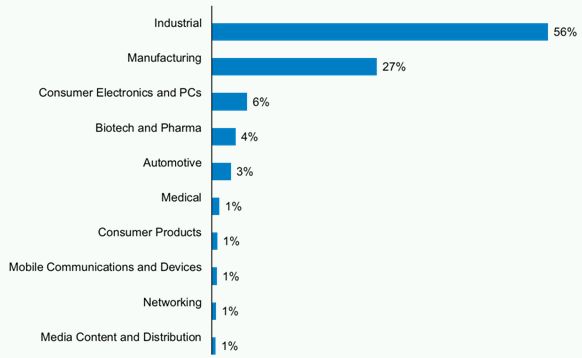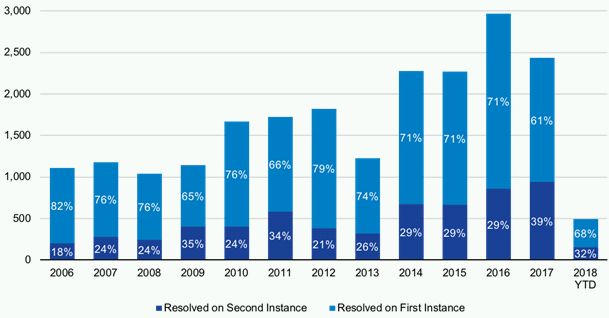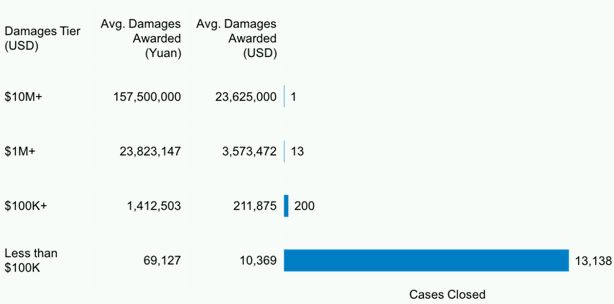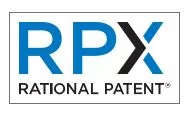The dramatic rise of patent litigation in China in recent years has created a need for insight into how the system performs—what kinds of cases are brought, how those cases turn out, and the potential risks posed by remedies in those cases.
In this post, we discuss the salient trends that have emerged from Chinese litigation data, focusing on the composition of caseloads for Chinese courts as well as on win rates and remedies at a system-wide level. Our dataset covers approximately 21,000 cases spanning more than a decade, from 2006 to the present. While the forthcoming integration of the data into RPX Insight will help practitioners answer more detailed questions for themselves, this post provides a first look at the available data.
RPX's previous blog post provides a concise summary of the many aspects of the Chinese patent system and patent litigation and how they differ from the US patent regime. There, readers can explore definitions and explanations of terms specific to the Chinese system as they are used below.
Our next blog post in this series will examine more closely how cases involving non-Chinese companies compare with those having only domestic parties.
Cases, Courts, and Market Sectors
The amount of Chinese patent litigation has nearly tripled in the last decade, going from slightly over 1,000 cases closed per year in the mid-2000s to nearly 3,000 cases closed in 2016.
The decline in 2017 and 2018, as indicated in Figure 1 below, may largely be due to inherent limitations in the reporting of Chinese litigation data: information on pending, dismissed, and settled cases is not available, and cases are not always reported immediately upon closure. As a result, totals for 2017 and 2018 are likely to rise as additional information becomes available.
Fig. 1: Cases Closed by Year

Note: Reporting limitations affect recent years; totals are likely to rise as additional data becomes available.
Unlike in the US, the venue distribution of patent litigation in China is highly correlated with population; there is no Chinese equivalent to the Eastern District of Texas. Figure 2 below shows that Chinese litigation is consistently concentrated in the populous coastal cities, especially in the provinces of Beijing, Shandong, Jiangsu, Shanghai, Zhejiang, and Guangdong.
This has continued to be true even after China began creating both specialized Intellectual Property Courts in Beijing, Shanghai, and Guangzhou and Intellectual Property Tribunals in other regions in late 2014 as part of an effort to reduce forum shopping. These courts have exclusive jurisdiction to hear first-instance patent cases.
Fig. 2: Cases Closed by Province

Chinese patent litigation is primarily focused on the industrial and manufacturing sectors, together comprising more than three quarters of the cases. Market sectors such as mobile communications, networking, and media content and distribution are rare among Chinese cases, despite constituting a much larger portion of American patent litigation.
Fig. 3: Cases Closed by Market Sector (Cases Closed 2006-2018)

Akin to district court cases in the US, first instance proceedings in China are brought in People's Courts (or, in provinces where one exists, an exclusive IP Court or IP Tribunal). The second instance represents an appeal from the decision reached by the court in the first instance. A second-instance proceeding is generally brought before a High People's Court or Supreme People's Court.
Generally, upwards of 20% of reported cases have terminated with a second instance proceeding, with an increase to nearly 30% in more recent years.
Fig. 4: Posture of Closed Cases

Outcomes and Remedies
Plaintiffs win the majority of cases that reach a merit-based outcome, while defendants get a "clean win" (a win on all asserted patents and claims) only about 20% of the time. Roughly 20-30% of cases involve a mixed outcome (often where multiple patents or claims are at issue).
RPX's next blog post will examine more closely whether cases involving foreign parties can expect similar outcomes.
Fig. 5: Outcomes on the Merits

Although at least some damages have been awarded in more than half of the cases closed since 2006, those damages have often been remarkably low, with the overwhelming majority amounting to $100K or less. Notably few cases have resulted in damages greater than $1M, and of those, only one case saw an award greater than $10M. Note that settlement figures are not publicly available.
As a result, the primary expense for foreign companies litigating in China is likely to be costs (which are not included in the damages amounts) and working around injunctions (see Figure 6 below).
Fig. 6: Damages Awarded by Amount (Cases Closed Since 2006)

While damages in Chinese patent litigation are low compared to the US, the rate of injunction issuance is quite high. When the plaintiff prevails (either outright or in a mixed-outcome judgment), an injunction is issued more than 90% of the time.
Although the factors that must be established for an injunction are similar to those in the US (with the plaintiff required to show a likelihood of success on the merits, that it will suffer irreparable harm absent an injunction, and that the injunction is not against the public interest), they appear to be applied much more liberally in China. This contrasts starkly with the US; since the issuance of the Supreme Court's decision in eBay v. MercExchange in 2006, US courts have generally been skeptical of requests for injunction.
Notably, injunctions by Chinese courts not only prevent the domestic practice of the patent but can also block export of patented articles. Thus, while damages are typically low, the risk presented by injunctions is substantial. Although the amount and frequency of settlements are unknown, the increased leverage provided by the threat of injunctive relief could theoretically push settlement levels above typical damages amounts.
Beyond damages and injunctions, Chinese courts also have the power to force the defendant to publish an apology, though this occurs in less than 5% of cases.
Fig. 7: Injunctions on Plaintiff Win (Cases Closed Since 2006)

Understanding the dynamics of Chinese patent litigation can help companies reduce costs and make smarter decisions when faced with the prospect of a case in China. With the number of cases per year steadily rising, knowing the risk of an injunction and the typical range of damages awarded enables companies to set a strategy that can give them the competitive advantage. As the Chinese patent litigation landscape continues to evolve, readers can always turn to RPX for the most comprehensive analysis of new developments and their business ramifications.
The content of this article is intended to provide a general guide to the subject matter. Specialist advice should be sought about your specific circumstances.

